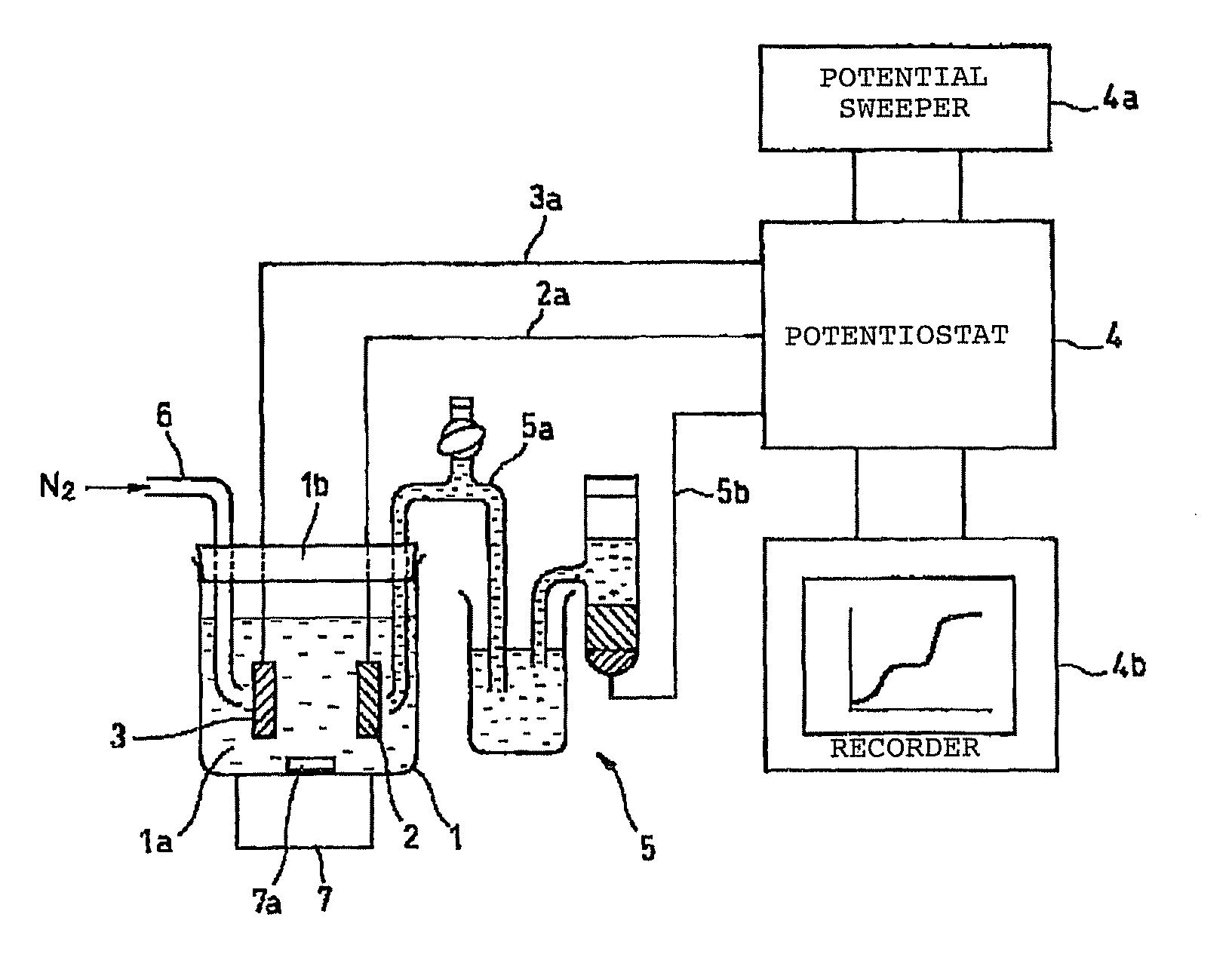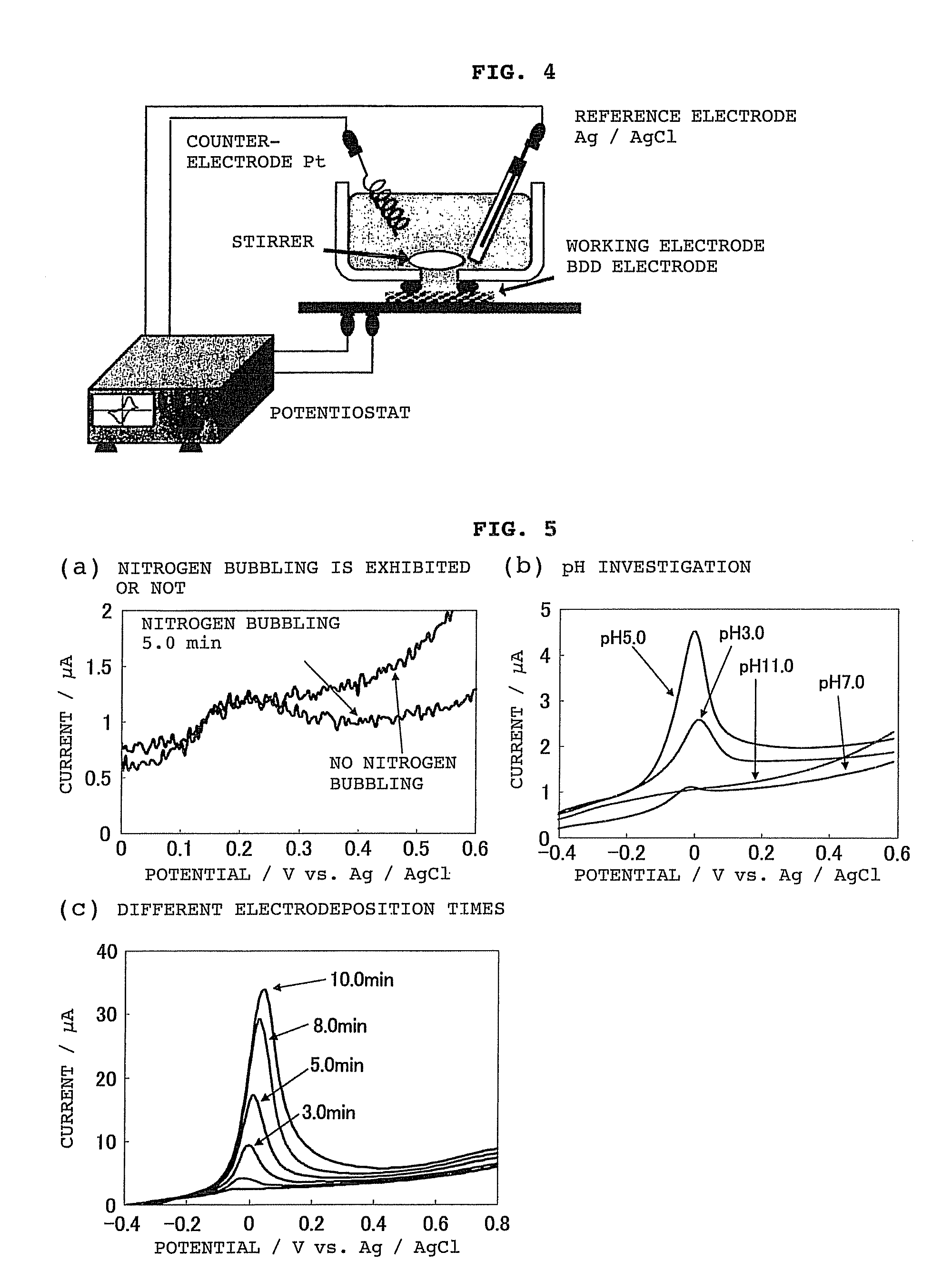Electrochemical analysis method using boron-doped electroconductive diamond electrode
a technology of electrochemical analysis and diamond electrode, which is applied in the direction of material electrochemical variables, liquid/fluent solid measurement, instruments, etc., can solve the problems of severe effects on society, arsenic poisoning and even death, and harm to humans, and achieves the effect of easy quantitative analysis and maximum accuracy
- Summary
- Abstract
- Description
- Claims
- Application Information
AI Technical Summary
Benefits of technology
Problems solved by technology
Method used
Image
Examples
embodiment 1
Measuring As (III) with a BDD Electrode
[0123]Using the system shown in FIG. 4, a solution containing arsenic was analyzed in this embodiment using a BDD electrode as the working electrode.
[0124]First, the electrodeposition time, solution pH and the like were tested in order to optimize the conditions for analyzing arsenic in a solution prior to testing. The results are shown in FIG. 5.
[0125]FIG. 5(a) shows the relationship between nitrogen bubbling and peak current value, while FIG. 5(b) shows the relationship between solution pH and peak current value, and FIG. 5(c) shows the relationship between electrodeposition time and peak current value.
[0126]These results showed the following conditions to be desirable, and these conditions were adopted for analysis.
[0127]Nitrogen bubbling does not seem to have any particular effect on the analysis results, but was set as follows in order to remove dissolved oxygen.
[0128]
Electrodeposition time:5 minutesSolution pH:5Nitrogen bubbling:5 minutes...
embodiment 2
Measurement of As(III) Using BDD-Au Electrode
[0137]Solutions containing arsenic at low concentrations were analyzed in this embodiment using a BDD-Au electrode as the working electrode.
[0138]Sample solutions containing 100 ppb, 300 ppb, 500 ppb, 800 ppb and 1000 ppb of As(III) were prepared, and the analysis method of the present invention was applied to these sample solutions under the following conditions using a BDD-Au electrode as the working electrode, with the results shown in FIG. 9.
[0139]
As electrodeposition potential:−0.4VAs electrodeposition time:60sSweep speed:200mV / sAu electrodeposition time:240s
[0140]It can be seen from this embodiment that a peak corresponding to concentration can be detected even at a low concentration of 100 to 1000 ppb by using a BDD-Au electrode as the working electrode.
embodiment 3
Measurement of As(III) Using BDD-Au Electrode
[0141]In this embodiment, analysis tests were performed as in Embodiment 2 except that the concentrations of the solutions were 10 ppb, 30 ppb, 50 ppb and 100 ppb.
[0142]The results are shown in FIG. 10.
[0143]It can be seen from the results of this embodiment that a peak corresponding to arsenic concentration in a solution can be obtained even at a low concentration of 10 to 100 ppb by using a BDD-Au electrode as the working electrode.
[0144]By way of reference, solutions containing 100 ppb of As were analyzed under the same conditions as in this embodiment using a BDD-Au electrode, BDD electrode, Au plate electrode and GC-Au (Au deposited on glassy carbon) electrode as the working electrodes. The results are shown in FIG. 11.
[0145]It is clear from FIG. 11 that while a clear peak appears using the BDD-Au electrode, no clear peak appears using the other electrodes. This shows that the BDD-Au electrode is especially suited to detecting arseni...
PUM
| Property | Measurement | Unit |
|---|---|---|
| oxidation-reduction potential | aaaaa | aaaaa |
| energy | aaaaa | aaaaa |
| flow rate | aaaaa | aaaaa |
Abstract
Description
Claims
Application Information
 Login to View More
Login to View More - R&D
- Intellectual Property
- Life Sciences
- Materials
- Tech Scout
- Unparalleled Data Quality
- Higher Quality Content
- 60% Fewer Hallucinations
Browse by: Latest US Patents, China's latest patents, Technical Efficacy Thesaurus, Application Domain, Technology Topic, Popular Technical Reports.
© 2025 PatSnap. All rights reserved.Legal|Privacy policy|Modern Slavery Act Transparency Statement|Sitemap|About US| Contact US: help@patsnap.com



